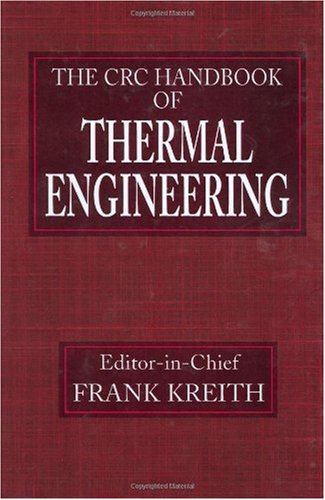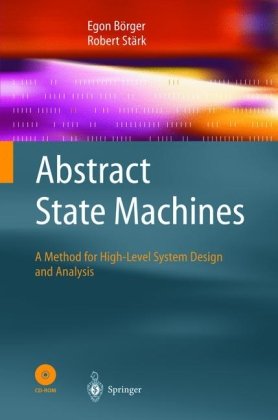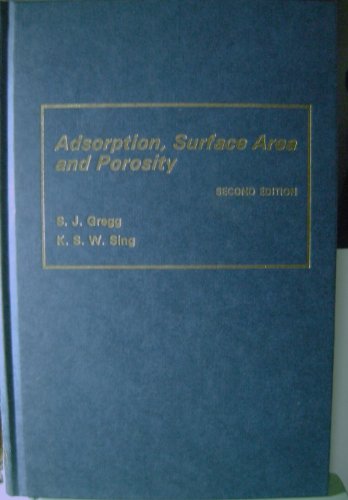Frank Kreith0-8493-9581-X, 9780849395819
Table of contents :
The CRC Handbook of Thermal Engineering…….Page 1
Acknowledgment……Page 3
Introduction……Page 5
Nomenclature……Page 7
Editor-in-Chief……Page 13
Advisory Board……Page 14
Contributors……Page 15
SECTION 3Heat and Mass Transfer……Page 19
SECTION 5Numerical Analysis and Computational Tools……Page 20
APPENDICES……Page 21
Engineering Thermodynamics……Page 24
Process, Cycle……Page 25
Temperature……Page 26
Work……Page 27
Heat……Page 28
Power Cycles……Page 29
Irreversibilities……Page 30
Carnot Corollaries……Page 31
Carnot Efficiency……Page 32
Entropy……Page 33
Entropy Balance……Page 34
Control Volume Energy Balance……Page 37
Control Volume Entropy Balance……Page 38
Control Volumes at Steady State……Page 39
Solution. The nozzle exit area can be evaluated using Equation 1.20, together with the ideal gas ………Page 42
Internally Reversible Heat Transfer and Work……Page 43
Basic Relations for Pure Substances……Page 45
Example 4……Page 46
Specific Heats and Other Properties……Page 47
Solution. Identifying x, y, z with s, T, and v, respectively, Equation 1.36b reads……Page 48
P-v-T Surface……Page 51
Compressibility Charts……Page 53
Equations of State……Page 58
Gas Mixtures……Page 59
Evaluating Dh, Du, and Ds……Page 60
Solution. With Equation 1.33 and the Maxwell relation corresponding to y(T, v) from Table 1.2, Eq………Page 61
Thermodynamic Data Retrieval……Page 63
Ideal Gas Model……Page 67
Example 8……Page 69
Solution. Using Equation 5¢ of Table 1.8 together with Equation 1.30b,……Page 71
Ideal Gas Mixtures……Page 72
Moist Air……Page 73
Generalized Charts for Enthalpy, Entropy, and Fugacity……Page 74
Multicomponent Systems……Page 77
Chemical Potential……Page 78
Ideal Solution……Page 79
Reaction Equations……Page 81
Solution…….Page 82
Enthalpy of Formation……Page 83
Absolute Entropy……Page 85
Solution. For combustion of liquid octane with the theoretical amount of air, the chemical equati………Page 86
Gibbs Function of Formation……Page 88
Solution. The overall cell reaction is H2 + 1/2 O2 Æ H2O(,), and Equations 1.83 are applicable. S………Page 89
Solution. The reaction of CO with the theoretical amount of dry air to form CO2, CO, O2, and N2 is……Page 90
Environment……Page 92
Control Volume Exergy Rate Balance……Page 93
Chemical Exergy……Page 94
Solution. Equation 1.88 reduces to read……Page 95
Exergetic Efficiency……Page 96
Solution. The exergetic efficiency from Table 1.13 is……Page 97
Introduction to Exergy Costing……Page 99
Solution. Substituting values into Equation 1.93,……Page 100
Rankine and Brayton Cycles……Page 101
Otto, Diesel, and Dual Cycles……Page 103
Carnot, Ericsson, and Stirling Cycles……Page 106
1.7 Guidelines for Improving Thermodynamic Effectiveness……Page 110
1.8 Exergoeconomics……Page 111
Exergy Costing……Page 112
Cost Balance……Page 113
Step 2: Definition of Fuel and Product……Page 114
General Example……Page 115
Exergoeconomic Variables and Evaluation……Page 117
1.9 Design Optimization……Page 118
An Iterative Exergoeconomic Procedure for Optimizing the Design of a Thermal System……Page 119
Case Study……Page 121
First Design Case……Page 122
Second Design Case……Page 123
Additional Iterations……Page 124
Principles of Economic Evaluation……Page 125
Levelization……Page 127
References……Page 128
Fluid Mechanics……Page 133
Hydrostatic Pressure……Page 134
Forces on Plane Surfaces……Page 135
Forces on Curved Surfaces……Page 137
Buoyancy……Page 138
Partially Submerged Body……Page 139
Uniform Linear Acceleration……Page 140
Rigid-Body Rotation……Page 141
Further Information……Page 142
Conservation of Mass……Page 143
Conservation of Momentum……Page 144
Conservation of Energy……Page 145
Solution:……Page 146
Mass Conservation–Continuity Equation……Page 147
Momentum Conservation……Page 148
Analysis of Rate of Deformation……Page 149
Relationship Between Forces and Rate of Deformation……Page 150
Energy Conservation — The Mechanical and Thermal Energy Equations……Page 151
Boundary Conditions……Page 153
Vorticity in Incompressible Flow……Page 154
Stream Function……Page 156
Solution…….Page 157
Further Information……Page 159
General Principles……Page 160
Example 2.3.1: Fully Developed Flow of Water Through a Smooth Round Pipe……Page 161
Algebraic Method……Page 162
Alternative Notations……Page 163
Example 2.3.2: Fully Developed Forced Convection in Fully Developed Flow in a Round Tube……Page 164
Example 2.3.3: Free Convection from a Vertical Isothermal Plate……Page 165
Correlation of Experimental Data and Theoretical Values……Page 168
The Evaluation of n……Page 169
Intermediate Regimes……Page 170
Example 2.3.4: The Pressure Gradient in Flow through a Packed Bed of Spheres……Page 171
The Turbulent Regime……Page 172
Overall Correlation……Page 174
References……Page 175
Basic Computations……Page 176
Fluid Friction……Page 177
Local Losses……Page 178
Pipe Design……Page 180
Pressure Class Guidelines……Page 181
Control Valves……Page 182
Torque……Page 183
Cavitation……Page 184
Transients……Page 185
Check Valves……Page 186
Air Valves……Page 187
Pump Selection……Page 188
Other Considerations……Page 190
Thrust Blocks……Page 191
References……Page 192
Uniform Flow……Page 193
Critical Flow……Page 194
Hydraulic Jump……Page 195
Weirs……Page 196
Gradually Varied Flow……Page 197
Solution……Page 198
References……Page 200
Introduction and Scope……Page 201
Boundary Layer Thickness Definitions……Page 202
Turbulent Boundary Layers……Page 203
Effect of Pressure Gradient……Page 204
Drag……Page 205
Pressure Drag……Page 206
Lift……Page 208
Profile Shaping……Page 209
Role of the Wind Tunnel……Page 210
References……Page 211
Introduction……Page 212
One-Dimensional Flow……Page 213
Normal Shock Wave……Page 215
One-Dimensional Flow with Heat Addition……Page 217
Quasi-One-Dimensional Flow……Page 219
Nozzle Flow……Page 221
Two-Dimensional Supersonic Flow……Page 222
Oblique Shock Waves……Page 223
Thin-Airfoil Theory……Page 225
References……Page 228
Fundamentals……Page 229
Flow Regimes……Page 232
Void Fractions……Page 234
Pressure Drop……Page 237
Minimum Fluidization……Page 238
Pneumatic Conveying……Page 240
References……Page 244
Classification of Non-Newtonian Fluids……Page 245
Constitutive Equations……Page 247
Modified Power Law Constitutive Equation……Page 248
Fully Developed Laminar Pressure Drops for Time-Independent Non- Newtonian Fluids……Page 249
Power Law Fluids……Page 252
Fully Developed Turbulent Flow Pressure Drops……Page 253
Viscoelastic Fluids……Page 255
Fully Developed Laminar Flow Pressure Drops……Page 256
References……Page 257
Introduction……Page 260
Fourier’s Law……Page 261
Plane Wall at Steady State……Page 262
Overall Heat Transfer Coefficient……Page 263
Internal Heat Generation……Page 264
Fins……Page 265
Bodies with Significant Internal Resistance……Page 268
Finite Difference Analysis of Conduction……Page 270
References……Page 272
Introduction……Page 274
Correlations for External Natural Convection……Page 276
Correlations for Open Cavities……Page 278
Heat Transfer in Enclosures……Page 280
Example Calculations……Page 282
References……Page 284
Introduction……Page 285
Flows with Zero Pressure Gradient and Negligible Viscous Dissipation……Page 286
Flows with Pressure Gradient and Negligible Viscous Dissipation……Page 291
Uniform Temperature: Flat Plate with Injection or Suction with External Flows of a Fluid Parallel………Page 292
Flow over Flat Plate with Zero Pressure Gradient: Effect of High-Speed and Viscous Dissipation……Page 293
Flow over Cylinders, Spheres, and Other Geometries……Page 295
Heat Transfer across Tube Banks……Page 297
Example……Page 300
Heat Transfer with Jet Impingement……Page 303
Bibliography……Page 304
References……Page 305
Introduction……Page 306
Heat Transfer Correlations……Page 308
Mixed Convection……Page 312
References……Page 314
Laminar Duct Heat Transfer — Purely Viscous, Time-Independent Non-Newtonian Fluids……Page 315
Turbulent Duct Flow for Purely Viscous Time-Independent Non-Newtonian Fluids……Page 318
Viscoelastic Fluids……Page 319
Free Convection Flows and Heat Transfer……Page 320
References……Page 322
Further Information……Page 323
Blackbody Radiation……Page 324
Radiative Properties of Surfaces……Page 326
View Factors……Page 328
Example 3.3.2……Page 333
Example 3.3.3……Page 334
Radiative Exchange between Opaque Surfaces (Net Radiation Method)……Page 335
Example 3.3.4……Page 336
Example 3.3.5……Page 337
Radiative Properties of Molecular Gases……Page 340
Example 3.3.6……Page 343
Radiative Properties of Particle Clouds……Page 344
Heat Exchange in the Presence of a Participating Medium……Page 345
Example 3.3.7……Page 346
Example 3.3.8……Page 347
Defining Terms……Page 348
References……Page 349
References……Page 0
Applications……Page 351
Introduction and Overview……Page 353
Distillation Processes……Page 354
Multi-Effect Distillation (ME)……Page 358
Vapor Compression Distillation (VC)……Page 359
Solar Distillation……Page 362
Reverse Osmosis (RO)……Page 363
Electrodialysis (ED)……Page 367
Defining Terms……Page 368
References……Page 369
Global Climate……Page 370
Average Temperature of Earth……Page 371
Albedo and Insolation……Page 374
Terrestrial Radiation……Page 376
Heat Reservoirs……Page 377
The Greenhouse Effect……Page 380
Energy Reservoirs……Page 385
Climate Variability……Page 386
Introduction to Model……Page 387
Methodology……Page 388
Carbon Emissions……Page 390
Climate……Page 392
References……Page 397
5.1 Computer-Aided Engineering (CAE)……Page 401
Approximate Solutions to a One-Dimensional Heat Equation……Page 402
The Crank-Nicolson Algorithm……Page 404
A Steady-State Problem — An Elliptic PDE……Page 406
Some Iterative Methods for Linear Equations……Page 407
Line (or Block) G-S and SOR Iteration……Page 410
The Dirichlet Boundary Condition……Page 411
Conclusions on Direct and Iterative Methods……Page 413
FEM Concept……Page 414
Weighted Integrals and Weak Forms of the Heat Equation……Page 415
A Simple Example of the FEM……Page 417
Quadratic Triangular Element……Page 420
Computing the Stiffness Matrix……Page 422
Integration over the Standard Triangle……Page 423
Some Rectangular Elements……Page 424
The Serendipity Element……Page 425
Three-Dimensional Elements……Page 427
Integration in Three Dimensions……Page 429
Line Integral in Two Dimensions……Page 430
Surface Integral in Three Dimensions……Page 431
Time-Dependent Problems……Page 432
Variational Forms of Elliptic Problems……Page 434
Error Estimates……Page 435
5.4 Boundary Element Method……Page 437
BEM in Two Dimensions……Page 439
Mixed Boundary Value Problem……Page 441
A Numerical Example in Two Dimensions……Page 442
More Accurate Integrations……Page 443
Three-Dimensional Problems……Page 445
General Purpose Interactive Mathematical Software……Page 446
Major Engineering Finite Element Packages……Page 447
References……Page 448
Appendices……Page 451
Symbols and Units:……Page 452
Part a. Ideal Gas Properties of Nitrogen, N2……Page 454
Symbols and Units:……Page 460
Symbols and Units:……Page 461
Part a. Temperature Table……Page 462
Part b. Pressure Table……Page 464
Symbols and Units:……Page 465
Part a. SI Units……Page 480
Part b. English Units……Page 482
Symbols and Units:……Page 485
Part a. SI Units……Page 486
Appendix C. Properties of Solids……Page 487
Part a. Pure Metals……Page 488
Part b. Commercial Metals and Alloys……Page 489
Definitions of SI Base Units……Page 490
SI Derived Units with Special Names and Symbols……Page 491
Conversion Factors — Metric to English……Page 492
Conversion Factors — General……Page 493
Conversion of Temperatures……Page 494







Reviews
There are no reviews yet.